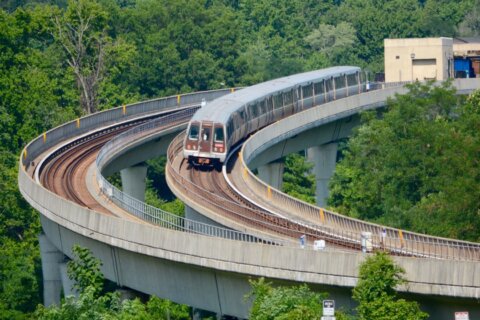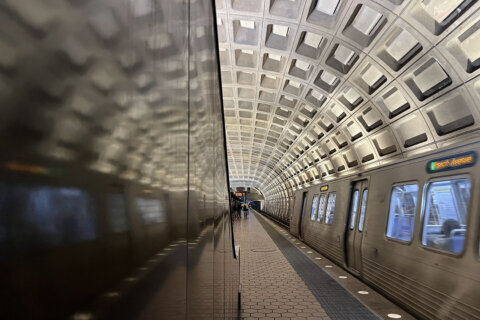Water seeping into Metro stations is putting electrical equipment, such as escalators and elevators, at risk, and a recent inspection even turned up stalactites growing above ceiling tiles in one station, according to a new safety audit.
Metro keeps a list of nearly a dozen stations known to face problems with leaks, flooding, pooling water and other issues, but doesn’t yet have a long-term plan for fixing them.
“Metrorail has not developed and implemented a comprehensive water intrusion and remediation program covering stations, elevators and escalators, which contributes to damage and deterioration of structures and other assets, to electrical hazards and to other safety risks,” auditors concluded in a report published by the Washington Metrorail Safety Commission on Wednesday.
The audit covered station maintenance, elevators and escalators throughout the 91-station Metro system. Overall, there are about 300 elevators and 600 escalators across all Metro facilities.
Auditors identified some positive developments in Metro’s maintenance of elevators and escalators, including the ongoing long-term plans to rehab and replace elevators across the system.
However, the report said site visits and documents reviewed by auditors turned up numerous locations with water-intrusion issues inside stations and in and around elevators or escalators, which creates electrical and structural risk.
For example, a recent Metro inspection at D.C.’s Farragut West station, which serves the Orange, Blue and Silver lines, revealed stalactites growing under a ceiling tile and a water leak along a joint, in the area between the fare gates and the escalator at the east end of the station.
The report did not indicate the size of the stalactites or include pictures. Stalactites, which are sometimes seen in caves and caverns, are mineral formations that develop over time due to dripping water.
At the Red Line’s Forest Glen station in Silver Spring, Maryland, the audit said water running from leaks was seen pooling and flowing in some exit pathways and ancillary rooms, including a room with circuit breakers.
At the Friendship Heights station, near the border between D.C. and Maryland, there was evidence of “numerous” ceiling water leaks and damaged ceiling tiles over electrical fixtures, especially around the elevator in the mezzanine area.
The safety commission also observed water intrusion in escalator and elevator areas at the Pentagon City station, and “indications of water intrusion such as pooling water or mineral deposits inside multiple other stations.”
Metro’s Office of Elevators and Escalators provided auditors with a list of 30 stations where water routinely seeps into elevators and escalators during heavy rain.
“However, there were no noted mitigations in place and no known causes specified for a majority of these locations,” the report stated.
In addition, Metro provided auditors with another list made up of 11 stations with known water-intrusion problems, “none of which have effective long-term mitigations in place,” the report stated.
The stations are Medical Center, Bethesda, Tenleytown-AU, Woodley Park, Forest Glen, Largo Town Center, Stadium-Armory, McPherson Square, Anacostia, Shaw-Howard U and Georgia Ave-Petworth.
“The only noted mitigation was ongoing testing of tunnel grouting meant to reduce tunnel leaks on part of the Red Line,” the report concluded.
Part of the problem is that responsibility for station maintenance, including elevators and escalators, is divided across different units, including the Plant Maintenance unit, the Office of Elevators and Escalators, and the Track and Structures unit.
Managers in the Office of Elevators and Escalators told auditors they do not lead or participate in a comprehensive water-remediation program, and managers in the Plant Maintenance unit told auditors lines of responsibility at Metro are “very blurry.”
That can make addressing “even a specific reported maintenance issue a challenge,” the audit report concluded.
The safety audit also pointed to a lack of training provided to mechanics who are required to fix elevators and escalators, especially on newer models of elevators and escalators that are newly installed.
An inspector stated that they had not been offered any training on new equipment or features,” the report stated. “Other mechanics stated that they have not had training on new equipment in several years, even as new types of units have been added to the system and they are regularly assigned to work on those new units.”
The audit also identified challenges filling vacancies, particularly on night shifts.
The safety commission issued a total of nine findings. Metro is required to develop corrective action plans to address them.
The safety commission said the audit reviewed documents beginning in November 2021 and conducted extensive interviews and site visits in December 2021.
In response to the report, Metro spokesman Ian Jannetta said, “Metro has received the audit report of our station maintenance, elevator and escalator programs. We appreciate the WMSC’s recognition of Metro’s program of elevator and escalator rehabilitation and replacement as a positive practice. We will work to implement corrective actions to address the WMSC’s findings and recommendations without delay.”







